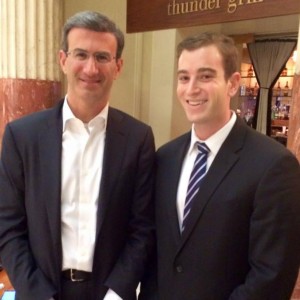by Amy Singh, COL ’14
 Back several years ago when I was a freshman at Penn, I had no clue what I wanted to do after graduation. I was completely ready to pursue my major in Japanese and minor in Fine Arts, but beyond that I didn’t know what my future path would be. I was considering everything from teaching, to translation work to going back to grad school to study Japanese in more depth, but the best answer I could’ve given you at the time would be that I really wanted to do something creative, that allowed me to combine my arts background with my interest in writing. Little did I know I would end up doing exactly that at an international UK-based company called BrightCarbon.
Back several years ago when I was a freshman at Penn, I had no clue what I wanted to do after graduation. I was completely ready to pursue my major in Japanese and minor in Fine Arts, but beyond that I didn’t know what my future path would be. I was considering everything from teaching, to translation work to going back to grad school to study Japanese in more depth, but the best answer I could’ve given you at the time would be that I really wanted to do something creative, that allowed me to combine my arts background with my interest in writing. Little did I know I would end up doing exactly that at an international UK-based company called BrightCarbon.
Welcome to the world of presentation design. In the world of niche industries and jobs, this is one that many people don’t realize exists. Ironically, there are tons of people working in marketing, sales and training whose main task is creating presentations for their teams, bosses or clients. People working in these fields may have different backgrounds, but they all have one thing in common, which is that most likely they have limited training when it comes to creating PowerPoint presentations. Because of this, many companies desire assistance with creating compelling, visual presentations, which is where the Presentation Design agency comes in. Part of this assistance is physically creating the slides themselves, but there are other aspects that come into play. For example, there’s also developing presentation messaging (similar to writing a script) to help companies position themselves as industry leaders, sell products, and explain concepts. And the last role at BrightCarbon is the role of Visualization Consultants like myself, which involves taking messaging and coming up with visuals for slides that communicate those messages well. Since this last role is what I am most familiar with, I wanted to dig a little deeper and get into what specific skills I learned at Penn that helped me become a Visualization Consultant, and what skills are useful to build if you are interested in a similar type of position.
The skills I use on a daily basis range from customer relationship management to reading comprehension to writing to more technical and Microsoft Office-related. Because this is a wide range of skills, the relevant classes are also varied, ranging from English to fine arts to business to technology-related. When combined, having some expertise in each of these areas will give you a great basis for working in presentation creation.
Writing
The most obvious skill that has helped immensely with my day-to-day is a solid foundation in writing. The type of writing that I use is different from writing a short story in Japanese for example, but nonetheless is related to the type of writing skills you build at Penn. When you learn how to structure arguments for a piece of writing with an introduction, main points and conclusion, you are inadvertently learning how to write an effective presentation. So many sales presentations we see are poorly structured, and follow a ‘We-we-we’ theme, meaning that they focus solely on how great the presenter is, and don’t actually get into what the value is for end users. In addition, more often than not content is disorganized, arguments are repetitive or presentations become too chart-heavy and end up being ineffective. A lot of these issues would be avoided if the messaging adhered to a solid structure, the same way a good story does, which is one of the things I got a solid understanding of between my various college seminar classes I took at Penn.
Reading comprehension
Another really important skill that I use every time I come up with visuals for a slide is analyzing text and thinking critically about what its key messages are. Because the average presentation will have 20 or more slides chock-full with text, going through each slide in detail could end up taking a lot of time. However, by putting into practice some of the methods I used at Penn (for example, breaking down information by highlighting the key sections, and skimming instead of reading) I’ve been able to shorten this time considerably. Being able to pick out key bits of information also helps with developing visuals for slides. Slides that are too information-heavy are not effective because the audience just ends up tuning out the presenter and reading the information on the slides. However, by focusing only on key points, you can create much clearer and effective presentations, that get your messages across to the audience. Many seminar classes in the college give you a taste of this type of reading analysis, which can make a significant difference in the effectiveness of your slides.
Business
As with any job, being business savvy comes in real handy. At Penn, some of the most useful classes for a career in presentation creation would be at Wharton. For example, marketing would come in handy for making sales presentations, since these presentations involve selling products and knowing how to communicate their value to end users. To add onto that, learning how to manage customer relationships is useful and knowing how to figure out what customers want and how to delight them with great customer service can never hurt. In general, learning how to communicate effectively in written and spoken word is crucial to collaborating on a presentation, which is definitely something that you can develop in different Wharton classes.
Graphic design
For people interested in working on presentations, taking a class in digital design can be useful down the road. If your main task is to create tons of PowerPoint slides, knowing how to lay them out, what colors look good together, and how to alter images in Photoshop can be very useful. Most people will say that they don’t have time to learn these types of skills, but if you learn how to do these kinds of things once, you will be able to make huge impact on the quality of slides you create. Introductory design classes at Penn will teach you design foundations which can be used to for things like using images effectively in your presentations, creating engaging PowerPoint templates and laying out your content so that it’s intuitive. This will make your presentations look one-thousand times better and also makes them much more effective. (To learn more about how to do great PowerPoint design, check out this article!)
Technology
The last important foundation for making presentations is to get a good handle on your weapon of choice, namely Microsoft PowerPoint. I learned many of the basics from a class I took in high school that focused on learning Microsoft Office, however, by the time I started working in PowerPoint full time there was still a lot more I had to learn. The best methods for learning all there is to know about how to use PowerPoint to its full potential would be to take online classes like BrightCarbon’s PowerPoint Master Classes, which can help you master a lot of the rarely-taught features of PowerPoint. Once you get in the swing of using more of PowerPoint’s functionality, it begins to come to you naturally and you can create more advanced and more effective presentations quicker and more easily.
Conclusion
I never thought I would end up making PowerPoints for a living, but you’d be surprised how many people do just that. These people might have different titles, like ‘brand manager’ or ‘product marketing manager’ or even ‘visualization consultant’, but in the end there are many careers where you may end up creating presentations frequently. Presentation design really is a lesser-known but massive industry with lots of job opportunities for designers and liberal arts graduates in general, and it really is great, as long as you don’t mind staring at PowerPoint for hours at a time. No matter what your degree may be, having a foundation in certain areas, namely writing, reading comprehension, business and design as well as technical skill (or the ability to learn) can take you very far in developing high quality, visually-effective presentations, and will help you shine among others as a presentation master.
Amy Singh is a self-proclaimed PowerPoint wizard and Visualization Consultant at BrightCarbon, an international (UK-based) presentation agency. After graduating from the college in 2014, she now spends most of her days planning her next Disney World vacation and also sharing the joys of PowerPoint with others.




